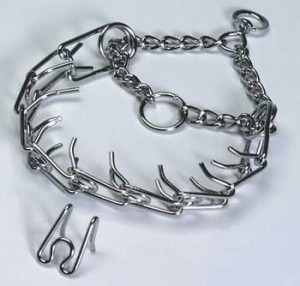There is a little daschund in our neighbourhood that I see periodically on our walks. The little daschund must weigh all of 8 pounds soaking wet. Her owners seem to really care about her because she gets walked regularly, even in this cold weather. I also believe this little daschund was probably a rescue, because it’s been the same size since I first saw her. Unfortunately I have never talked to their owners because this little daschund is leash reactive (she barks, lunges, and acts aggressively when dogs get close by).
A short while after the daschund arrived in the neighbourhood, I noticed that they began walking the dog on a pinch collar (also known as a prong collar). For those of you who (fortunately) do not know what a pinch collar is, here is a picture of one:
A pinch collar is a tool of punishment. If the dog pulls, the metal ends jab into the dog’s neck causing pain, which causes pulling to stop. If a leash correction (leash tug) is applied firmly, the metal ends jab into the dog’s neck also causing pain. Most dogs will walk gingerly and carefully when you put a pinch collar on them to avoid pain, so they are often used by dog owners who are too impatient to teach loose leash walking.
The owners of the daschund, while on walks, would apply a leash correction every time the dog barked, lunged, or reacted to nearby dogs. Very quickly (within a couple of short weeks), the daschund’s outbursts stopped. She could walk right by me while I was walking Petey and it was as if the little daschund didn’t even see him. On the surface, I’m sure the owners of the daschund were delighted with the results.
A few months after that, I would see the daschund being walked in the neighbourhood, and thankfully, the owners had switched to using a harness. We’d run into each other while walking our dogs; I did my best to give the little girl enough space, and despite the removal of the pinch collar, she still was able to walk by without outburst. I remember being impressed that she was still suppressing her outbursts despite the absence of the pinch collar (this was summer). But I knew all was not fixed with that dog. When I see quiet and still dogs that are reactive or fearful, I think back to this German proverb:
“The silent dog is the first to bite.”
Fast forward now to January. Petey and I were out for our afternoon walk and we see the little daschund again. I actually didn’t recognize her at first since she was all bootied and coated up. As Petey and I walk by, she started barking, lunging, and pulling towards us. Because the threat of punishment is now a long gone memory, her old behaviors have returned.
The moral of the story is – the heart rules the head. Fearful, aggressive, and reactive behaviors are rarely driven by conscious decisions – they are driven by emotions. When behaviors are driven by emotion, the only way to change the behavior is to change what’s in the dog’s heart. The pinch collar never helped the little daschund learn to be confident – in fact, she looked quite depressed while she wore it. It never helped her learn to feel comfortable around dogs – in fact, the sign of a dog coming meant the risk of leash correction was imminent. All the dog learned to do was stay still and bottle her feelings up.
I can understand the allure of a “quick fix”. I wish I could help my clients with reactive dogs walk by other dogs in close quarters and be cool with it in a matter of a couple of minutes. I can’t – but a punishment trainer can throw on a pinch collar and create an illusion of a “fix”. But it’s just temporary suppression – not long lasting change. My clients, however, day by day, week by week, are slowly changing what’s in their dog’s hearts. And once you have changed what is in a dog’s heart, their head will follow.

